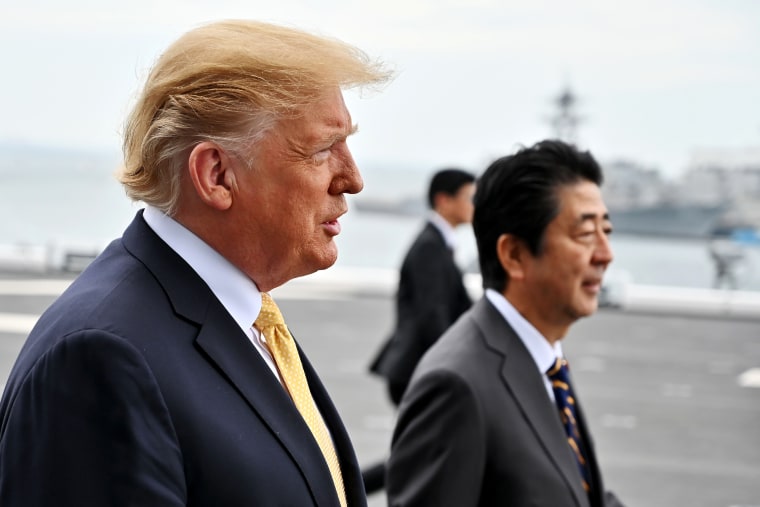In the frenzied exchanges of international commerce that have played for almost a year, news of Japan has been relatively quiet. But, with premier Shinzo Abe marking the first visit by a prime minster to Iran since the Islamic Revolution — and as America's fourth-largest trading partner — global economists are wondering how long it could be before President Donald Trump takes aim at Japan, as he has done with China, Mexico, and the European Union.
Like many other countries, Japan has a trade imbalance with the U.S., buying $75 billion worth of goods in 2018 and selling $143 billion.
"I don't see how the U.S. doesn't turn its guns to Japan" after NAFTA and China, said Robert Uriu, professor of political science at the University of California, Irvine. "Japan is in this terrible dilemma. They don't trust what the U.S. is doing, but in terms of their current options, especially with a rising China, I think they're seeing they don't have much of a choice, so they have to somehow placate the United States."
The hot-and-cold history of trade between the U.S. and Japan reaches back to the 1850s, when American whaling ships needed supplies, according to Ethan Segal, associate professor of history at Michigan State University.
Things went into an understandable retreat during the Second World War, but later, the two countries agreed to a low exchange rate that allowed Japan to sell manufactured goods to the U.S.
"As the Cold War was beginning to manifest itself, we were very interested in having a stable ally in the South Pacific," Segal said.
However, tensions between the two countries hit a peak in the mid 1980s, after the Japanese radically improved the quality of their manufactured goods and were making heavy inroads into such U.S. sectors as cars and steel. Most Americans found the Japanese economic threat to be greater than the possibility of war from the Soviets, Segal said.
By 1990, Japan had strengthened into the world's second-largest economy, exporting high-end electronics, autos, and other products.
Since then, Japan's economy has been in a long downward slide, fueled by falling land prices that backed loans and an aging society where a decreasing base of working-age adults has to support older generations. "For the last 30 years, Japan's growth has been nil," said Jeffrey Bergstrand, professor of finance at Notre Dame's Mondoza College of Business. "Japan used to be 67 percent of the U.S. economy — and now it's about 40 percent because of its low growth relative to ours since about 1990."
But the country remains an important trading as well as investing partner. "If you drive a Toyota, there's a good chance it was built in Kentucky," Segal said. "If Honda, it was probably Ohio." And the chance that it stays clear of trade war mania is diminishing.
Trump has planned a 25 percent duty on imported cars from both Japan and the European Union, although in mid-May, Trump said that he would delay implementation for six months.
Prime Minister Abe has developed an apparently good personal relationship with Trump, but the statement at the end of the president's recent trip to Japan was revealing, in that there was confusion as to whether the U.S. agreed not to raise tariffs so long as the two countries were in discussion.
"That's how the Japanese understand it, and it's clearly implied in the agreement," said Paul Sracic, professor and chair of politics and international relations at Youngstown State University, who was in Japan during the meeting.
Additionally, Japan is part of the Comprehensive and Progressive Trans-Pacific Partnership, formerly the Trans-Pacific Partnership before Trump pulled the U.S. out of the agreement. That agreement constrains how far Japan can drop tariffs on things like agricultural goods, a big area of import from the U.S., before it is forced to offer the same to other members.
"Trump immediately countered and basically discounted, saying we're not involved in TPP, so what other countries agreed to doesn't apply to the U.S.," Sracic said. "Politically, it's important for Trump to send a message to his voters in the Midwest that he is aggressively renegotiating these trade agreements, whether we're talking about NAFTA or a TPP-like trade deal with Japan. It's all pointing toward 2020."
But, also like China, Japan considers long-term strategy and interests, Bergstrand says. That is why, during the talks, Abe mentioned direct investment in Ohio, Pennsylvania, and Michigan — three states that Trump would need to gain reelection.
"What I think Japan's going to try to give is a deal increasing their direct investment, particularly in manufacturing in the swing states," Sracic said. "That's going to be their way out. Then Trump can say, 'I got something.'"
Then, if Trump wins in 2020, Abe can consider that he gained a foothold to possibly hold off another change in mind on the part of the administration. And if Trump loses, there's always someone else to work with going forward.
